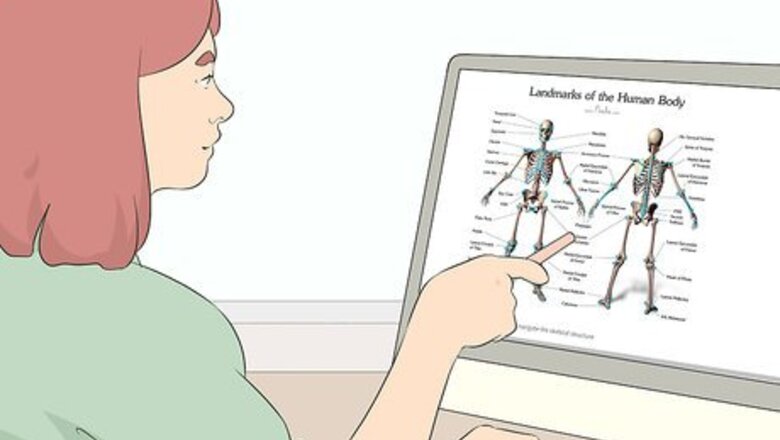
views
- Identify major bones, muscles, and tendons that are visible through the skin and how they move together in different poses and motions.
- Draw simple shapes to give to the body, following typical human body proportions. Map the muscle structures you’ve studied onto your figure’s shape.
- Practice drawing your figure in different poses and different angles. Consider how each move would affect the rest of the body’s movement.
Studying Major Body Parts & Their Motions

Study skeletal structures that are visible on the body’s surface. Some bones are often visible through the skin, and familiarizing yourself with them can help you draw them when you’re sketching a figure. They’re also helpful for understanding the overall shape of the body and giving you a framework for figure drawing. Some of these easily-identifiable spots include: The collarbone, which is located where the neck and chest meet. The elbows, located where the upper and lower arms meet. The spine, which runs down the middle of the back. The kneecaps, which are found between the upper and lower legs. The ribs, located at the front of the torso below the chest.

Focus on the shapes of the major parts of the skeleton. Learn the shapes of major bones like the skull, femur, and pelvis before stepping back and learning the overall shape of the feet, hands, and other smaller bone structures. There’s no need to memorize the names and locations of every bone in the body. However, getting a sense of what fits where in the body is the key to successfully learning anatomy and applying it to your art. Once you understand how the skeleton is built, you can practice drawing it in different poses.
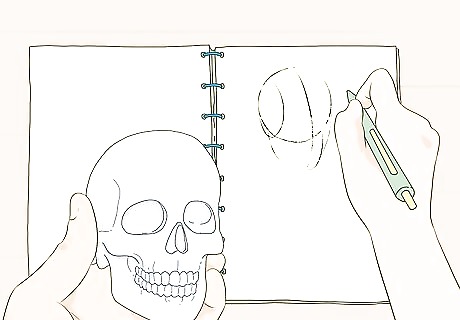
Manipulate and observe a model skeleton’s movements. Take note of how the joints connect the bones. Try different poses and watch how the bones change positions. Since you will rarely draw a person standing perfectly straight, it’s important to get a sense of how the skeletal system works and looks in other poses. For practicality, opt for a mini (but realistic) skeleton model or watch animations of skeletons moving online.
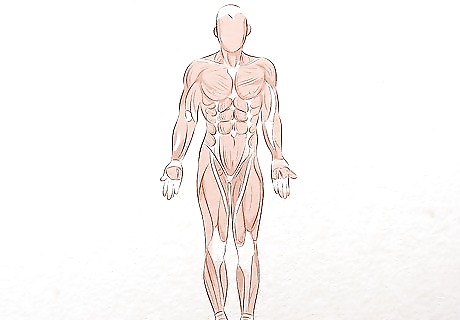
Memorize the major masses of the body. As with the skeleton's major sections, there are landmark muscles that form masses visible through the skin. The muscles that contour the torso form the largest of these masses. The glutes and the muscles on the arms are also typically pronounced. Start learning with the largest of these and move on to smaller ones as you get more confident about the shapes of the large ones.
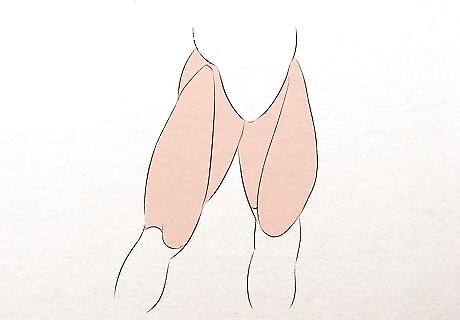
Study the different muscle groups. Rather than learning the name and location of each muscle, focus on major muscle groups. Learning the function of each muscle group and where it’s located will make it easier to draw a realistic human figure. The major muscle groups you should focus on include: The quadriceps, which are located at the front of the thighs. The hamstrings, which are located on the back of the thighs. The calves, which are found on the back of the lower legs. The chest muscles, located directly over the chest. The back muscles, which stretch across both the upper and lower back. The shoulder muscles, which are found on the front, side, and back of the shoulders. The triceps, located on the back of the upper arms. The biceps, which are found on the front of the upper arms. The forearms, which are located on the lower half of the arms. The abdominal muscles, which are found over the lower half of the torso.
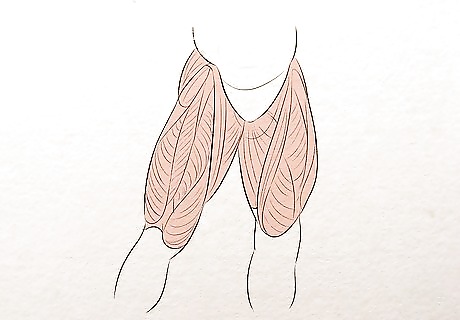
Learn about the visible tendons alongside the muscle groups. Like bones, muscles have connections between them that dictate how they move. Some tendons in the body are visible above the skin, and it’s helpful to study them so you can recognize them when you’re drawing a figure. Keep in mind that the appearance of the tendons can change depending on how a person is positioned. For example, the Achilles tendon, which connects the calf muscles to the heel bone, is visible on the back of the leg.
Sketching Basic Anatomical Shapes
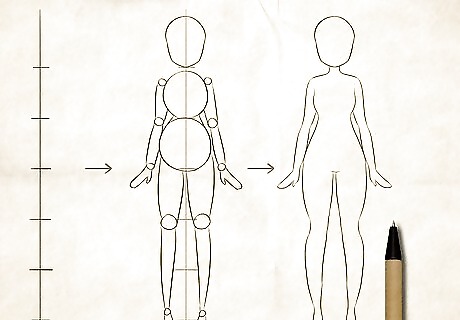
Draw simple forms to establish shape and dimension. Use a circle for the head, a rectangle for the chest, and an oval for the pelvis. You can use small circles for major joints, like the shoulders, elbows, hips, and knees, and represent the spine with a curved line. Or, draw 3D shapes like cylinders for the thighs and lower legs, spheres for the knee caps, and a cube for the upper torso. Every human body is different, but they all share some common simple forms that you can use to create a basic outline for your drawing. Starting with these simple forms will make it easier to capture the figure’s movement and overall shape. With some practice, you won’t need this reference to correctly use anatomy in your art.
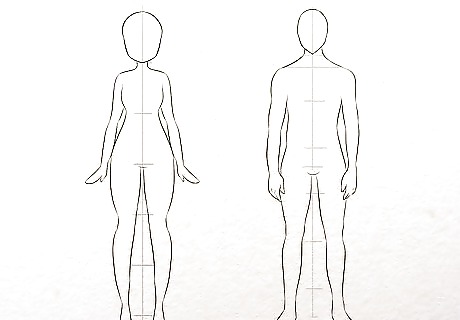
Focus on bodily proportions. In contrast to medical anatomy, anatomy in art must pay close attention to drawing accurate human body proportions. Trace a figure with proportional anatomy from a book and use the measurements of the head, torso, arms, legs, hands, and feet as a guide for how much bigger or smaller one part or another should be. Proportions are often measured in terms of “heads.” For instance, the center of the chest is typically the same distance from the bottom of the head as the length of the head itself, a distance called “2 heads.” The navel is considered to be “3 heads” down. Other head-based proportions include the crotch, which is 4 heads down, the knees, which are 2 heads below the crotch, and the feet, which are 2 more heads lower than the knees. For arms, some example proportions are the shoulders, which are around 1/4 of a head below the chin; the elbows, which are level with the belly button; the wrists, which will line up with the hips, and the fingertips, which fall just above the mid-thigh. Many artists draw with exaggerated proportions, especially when drawing cartoon characters or sketching fashion designs. Exaggerating body proportions is fine, but you have to respect basic body anatomy to draw accurately.
Drawing Realistic Muscle Structures
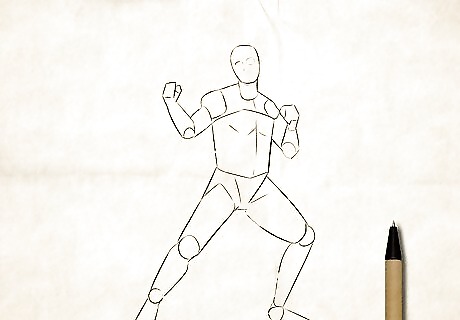
Sketch the skeleton before moving to the muscles and skin. Draw figures as skeletons, then add the musculature to the sketch. Once you have added muscles, draw the skin on top and reduce the muscular and skeletal detail to see how the anatomy looks as a standard figure drawing. Be sure to start with the skeletal and mass landmarks you learned and try different poses to get a sense for where they will be in those positions. Try drawing people of different shapes and sizes to see how the anatomy changes, especially the muscle and skin layers. Artists beginning to use anatomy as a guide for their figures often start by drawing the body in anatomical layers. As you improve, start to abstract the skeleton and muscles into chunks so that you can draw the layers much more quickly.
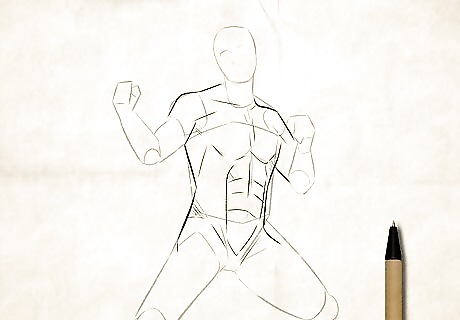
Draw the torso and abdomen. Typically, the torso’s muscle structure includes two large chest muscles, abdomen muscles, and muscles on the side of the abdomen that wrap around to the back. For female figures, draw the waist smaller and draw breasts extending from the front of the chest muscles. In general, a male torso will have broader shoulders and narrower hips, while they will be more even on a female torso.
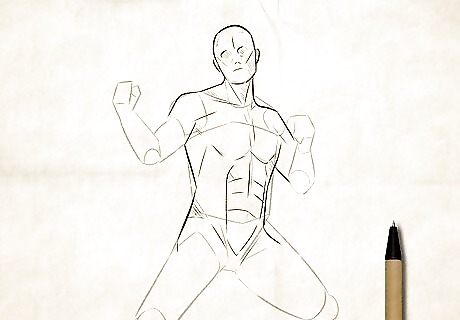
Draw the head and face. Divide the face into three equal horizontal sections: the top of the head to the top of the eyes, the top of the eyes to the bottom of the nose, and the bottom of the nose to the bottom of the chin. Draw the ears in the middle section. Further divide the face into three vertical sections: align the eyes’ inner corners with the nose’s outer corners and the mouth’s outer corners with the center of the eyes. Consider how the cheek bands will move and stretch when your figure smiles or creates different facial expressions.
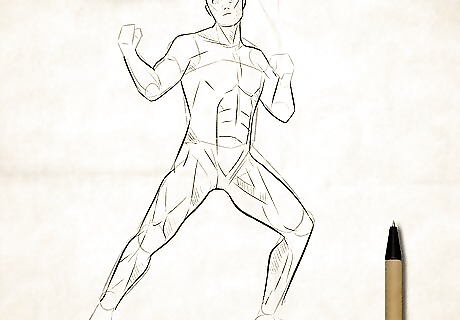
Draw the arms and legs. The arm includes the shoulder, upper arm, and lower arm muscles. Draw the shoulder muscle as a slightly misshapen heart with the upper arm muscles coming down from the bottom point. Draw the lower arm muscles extending from the elbows and connecting to the hands. Draw legs by starting at the top where the pelvis is. The front of the leg contains three main muscles, while the back contains the large glute muscle above the hamstring.
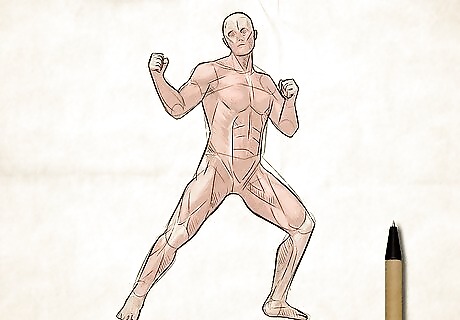
Draw the hands and feet. Refer to photos of hands and feet and sketch them using basic shapes. For example, draw the palm of the hand as a pentagon with long rectangles as the fingers. You could also draw the feet as rounded rectangles with small circles for toes. Define the shape of the hands and feet and add details like nails, knuckles, and palm lines.
Studying Drawing Examples That Use Anatomy
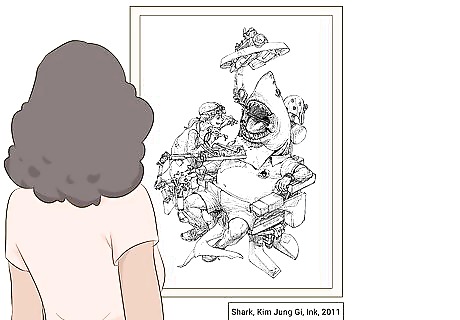
Look closely at the anatomy of figures in your favorite works. To see how other artists have applied their knowledge of anatomy, look at how the body is depicted in your favorite pieces. Whether you’re a comic book artist or an aspiring oil painter, learning the anatomical styles that you want to emulate will give you a goal to strive for. It’s important to balance an accurate representation with your own drawing style.
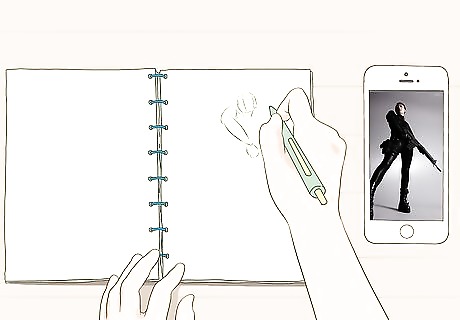
Practice drawing from pictures, sculptures, dummies, and live models. The more types of figures you draw from, the more familiar you’ll get with human anatomy. Sketching figures from photographs is a great place to start, but don’t stop there. Use human dummies or mannequins to practice drawing from three-dimensional figures. You can also take an art class so you can practice drawing from live models.

Work with an anatomy book or video series as you practice. One of the best ways to learn anatomy is to read a book or watch videos on the topic, focusing on the parts that are relevant to drawing. If the book is designed for artists, it will be even more helpful. One of the most popular books on the topic is Artistic Anatomy by Paul Richer. As you read or watch, it’s important to sketch the different body parts along with the book or instructor.












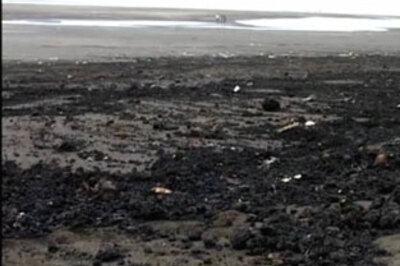







Comments
0 comment